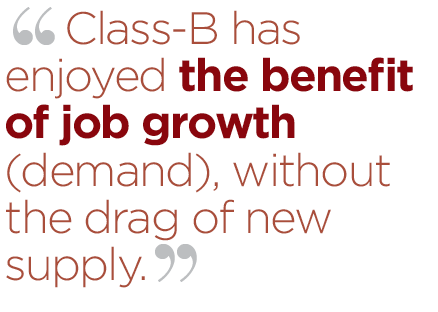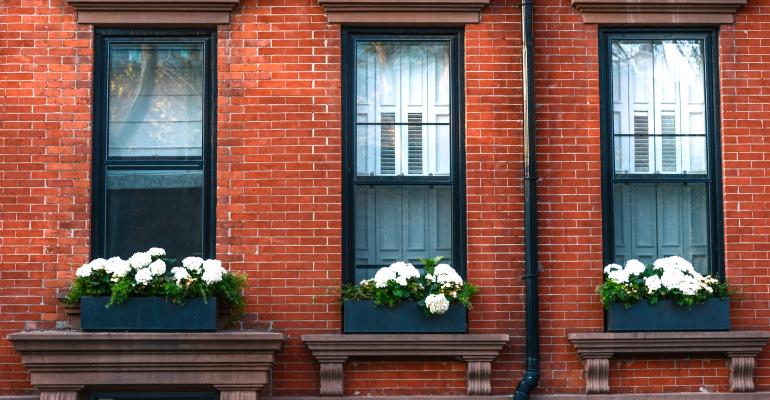Class-A apartments in core neighborhoods may no longer be the best investment in today’s market. Vacancy rates are rising for the most expensive apartment communities in urban neighborhoods, research shows.
“The urban class-A market is seeing some pressure. It’s not a crisis by any means, but it’s now an underperforming segment of the market,” says Jay Parsons, an expert with MPF Research, a division of RealPage, Inc., an apartment market intelligence firm. “We expect that to remain the case through 2016 and likely into 2017.”
The pressure is due to the fact that developers are building so many new luxury apartments in urban areas, especially in downtown districts. Vacancy rates are lower and rent growth is steady for apartment communities that don’t have to compete so hard to attract renters---including class-A apartment communities in suburban areas, where there isn’t so much new construction, and class-B apartment communities everywhere.
“Class-A vacancy rates will continue to rise, while class-B vacancy should decline as few developers build class-B buildings,” says Barbara Byrne Denham, economist with New York City-based research firm Reis Inc. “Rents should continue to rise, although the rate of growth for class-A rents will be lower than it has been. The rate of growth for class-B rents should stay the same.”
Vacancy rates fall for class-B apartments
Usually, class-A communities have significantly fewer vacant apartments than class-B communities. Over the last dozen years, from 2003 to present, the class-A apartment vacancy rate averaged 5.2 percent. That’s 40 basis points lower than the vacancy rate for class-B apartments. But that difference has vanished as class-B apartments catch up to class-A—both had an average vacancy rate of 4.9 percent over the last two years, according to data firm Axiometrics Inc.
“Class-B has enjoyed the benefit of job growth (demand), without the drag of new supply,” says Jay Denton, senior vice president with Axiometrics. “Class-B properties are priced at the midpoint of the market, and more people can afford them.”
 Other data firms show class-B communities posting better fundamentals than class-A properties, with an average class-B vacancy rate that fell from a high of 8.1 percent in 2010 to just 3.2 percent in the second quarter of 2015, according to Reis. That’s far below the average vacancy rate of 5.7 percent for class-A apartments in the second quarter.
Other data firms show class-B communities posting better fundamentals than class-A properties, with an average class-B vacancy rate that fell from a high of 8.1 percent in 2010 to just 3.2 percent in the second quarter of 2015, according to Reis. That’s far below the average vacancy rate of 5.7 percent for class-A apartments in the second quarter.
However, rents have grown slowly at class-B apartments over the last few years, at a rate of approximately 2 percent a year, compared to more than 3 percent for class-A apartments.
“Class-B and class-C landlords are unable to increase rents significantly for this large segment of the population, who do not have the income support to pay higher rents, while landlords of class-A units clearly can raise rents,” says Reis’ Denham.
Vacancies rise for downtown class-A apartments
In urban downtowns, where developers have built many new apartment buildings, the vacancy rate for class-A properties is sometimes significantly higher than at class-B buildings.
For example, 5.5 percent of the class-A apartments are vacant in the urban core of Austin, Texas. That’s more than twice the 2.4 percent vacancy rate for class-B properties, according to Axiometrics. Class-A properties also suffer from higher average vacancy rates compared to class-B building in the urban cores of Denver, Seattle and Houston.
In Dallas, where the urban, core sub-market has absorbed a great deal of new apartments, the vacancy rate is the same for both class-A and class-B properties at 4.6 percent. “We have seen some positive momentum in terms of rent growth, which suggests the urban core has ‘recovered’ from the influx of new supply,” says Sophie Zatterstrom Gore, analytics workflow manager for Axiometrics.
In suburban areas, class-A properties are performing much better.
“Suburban class-A is performing phenomenally well and we are bullish on the outlook too,” says MPF’s Parsons.
That’s because relatively few developers are building in the suburbs, where resistance to development and restrictive zoning laws keep many builders away. The inventory of apartments has grown more quickly in central business districts than in the suburbs since 2007.
“The gap has widened substantially in recent years… and will remain unusually wide through the next few years at least,” says Parsons.

